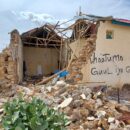Al-Amud al-Akhdar: Strata of Conflict in Darfur’s Deep South
The establishment, development and destruction of the settlement of al-Amud al-Akhdar in Darfur’s deep south forest belt provides a microcosm of Sudan’s modernization projects and their contradictions, interlocking strata of conflict, and their violent manifestations in the recent Darfur war.
Until 1970, al-Amud was no more than seasonal-cattle camp used by Habbaniya Baggara pastoralists in the dry season, and hunters from Nyala, the northern limit of the abortive cordon sanitaire misguidedly created by British administrators between the baggaraArabs of South Darfur and the Fertit ethnic groups, that were arbitrarily designated as non-Arab and belonging to South Sudan. At that time, Qoz Dango was virgin forest, inhospitable to permanent settlement because of the absence of surface water for fully four months of the year. The advent of deep tube well technology (the “donkeys” with their distinctive chequerboard water tanks) meant that by the 1960s this situation had the potential for radical change.
Enter the Sudan government in the optimistic high noon of modernization (and briefly socialist) combined with the World Bank and Hunting Technical-Services, which between them created the Western Savanna Development Corporation. One of the WSDC objectives was environmentally sustainable agro-pastoral development, taken to include establishing cattle ranches in place of transhumant pastoralism, the resettlement of drought-stricken nomads from northern Darfur, and the creation of model farming system settlements with regulated crop rotation and livestock ranching. The planners’ vision was to learn from earlier less successful experiences in settling nomads and setting up mechanized farms, to create a smallholder based, environmentally-sustainable, model of development. As the sedentarization proposals for the Missiriya floated by Hafiz Mohamed indicate, this is an idea that still retains a strong hold on the Sudanese intelligentsia. Irrespective of their diverse political leanings, Sudanese elites aver that modernization project equals permanent settlement and the death of nomadism.
In pursuit of sustainable sedentarized agro-pastoralism, the WSDC conducted extensive land-use surveys and employed a highly qualified sociologist with the aim of ensuring that the settlement plan was suitably integrated into the existing socio-economy of the host district, while also monitoring the success of the settler community in following their projected social transformative trajectory over time. One of the four locations selected for this pioneering modernization experiment was al-Amud and over the following two decades,, al-Amud and its three sister settlements became some of the best-documented experiments in planned agrarian development in Sudan’s savanna belt.
The WSDC’s initial plan was to bring drought-stricken pastoralist Zaghawa from Um Burro, in the semi-arid belt of north Darfur, but the first settlers who arrived in al-Amud found it difficult to adapt to the contrasting ecology of their new domicile and most of them returned to the north at the first opportunity. The WSDC altered the plan to include an additional quotient of Habbaniya pastoralists. Thereafter, al-Amud took on a different role to the developmental-modernism that the planners had determined upon. Rather than being a template for a sustainable scientific farming system, al-Amud developed into one node in an expansive network of Zaghawa farmers, traders, money-lenders and commercial-herders, linked across the length and breadth of Darfur and even further afield, into Central-African Republic. It was a minor node but an important one insofar as the WSDC investment in the settlement ensured that basic services were maintained better than in many other places.
The actual-historic as opposed to planned-ideal developmental trajectory of al-Amud is best understood in reference to the greatest modernization experiment in modern Sudan, namely the Gezira Scheme. The roots of the world-famous Scheme, still the world’s biggest irrigated farm, lie in the Lancashire Cotton Barons’ appetite for high quality cotton at the turn of the twentieth century as well as the colonial administration’s financial balance sheet. It was and remains one of the African continent’s few sustained efforts at truly industrial-agriculture. Gezira represents a hydraulic model of agrarian development, requiring an extraordinary level of bureaucratic centralism which regulates water use, fertilizer use, crop planting schedules, etc. If ever there was an attempt to create an authentically developmental-socio-economy in tropical Africa, the Gezira Scheme was it. The roots of the Sudan Communist Party in the Tenants’ Union as well as the railway workers, are testament to the incipient class structure that emerged, and its potential to act as a vanguard for a progressive political economy.
It is tempting but incorrect to attribute the collapse of that hope to the merciless crushing of the Communists in 1971. Already by then, under successively military, sectarian and (briefly) socialist regimes, the Gezira Scheme had been captured by rent-seekers, at all levels. Social scientists including Tony Barnett and Abbas Abdel Karim were correct in describing Gezira as “an illusion of development.” The state itself extracted the maximum surplus for the minimum investment. It has remained essentially unchanged over the subsequent decades, in which the Scheme has languished, despite repeated “rehabilitation” efforts amply financed by the World Bank and other gullible donors. The aid rents from the repeated rehabilitation programmes were more valuable to the state bureaucrats, who persistently diverted them to sustain the state’s own infrastructure, than they were in terms of any increased returns to the Scheme itself and its putative proletariat or, alternatively, kulak class. For the lease-holder, it became more profitable to rent out the land (an act that was, strictly speaking, against the terms of the lease) than to farm it himself. With inputs in short supply, and cotton prices strictly regulated to the disadvantage of the producer, it was rarely profitable to farm at all and the question arises, why so many tenants persisted. Closer examination reveals that, for most producers, the principal value of the Scheme became not the return on agricultural production, but the social services extended to the residents of Gezira, most particularly primary and secondary education, which was (and is) among the best in Sudan, with the particular bonus that it is not necessary to reside in an urban area to obtain it. Consequently, continued residence on the Gezira Scheme and fulfilling minimum state production demands was the price paid by the residents for the upward socio-economic mobility of their sons and daughters. Meanwhile, the labour camps that had initially been seen as a temporary measure to house seasonal-migrants, still regimented in colonial style, became institutionalized as permanent features of the landscape, and the migrant labourers, many of them from Darfur, evolved into a permanent underclass. Such a contradictory political economy necessarily was manifest in bizarre political manifestations. Thus the Sudan Communist Party became sectarian-ized in reflection of its leaseholder constituency, increasingly bourgeoisified in aspiration and rent-seeking behaviour if not in lifestyle, while the migrant workers, grossly exploited through their lack of permanent residence rights, remained loyal to the Umma Party. Many of these agrarian lumpenproletariat, on the mechanized rainfed schemes of Gedaref as well as Gezira, were Darfurians. One might see the spectacular failure of the Darfurian liberation fronts to develop a national revolutionary project, as opposed to relapsing into provincial revanchism, as symptomatic of their failure to analyse this experience and drawn upon it. The parallel would be if the ANC, instead of mobilizing in the townships and hostels, mobilized in the Bantustans exclusively. That, however, is a different story which cannot be pursued here.
The Gezira model was replicated in New Halfa and other settlement schemes and the imprint of the entrenched tradition bureaucratic centralism can be seen in the WSDC schemes as well, albeit leavened with the then-fashionable developmentalist admiration for small-holder farming systems. Similarly, the al-Amud residents followed the time-honoured strategy of using the settlement for their own diversified strategies for income generation and in particular exploiting the scheme’s strategic location, on the frontier of cultivation and on illicit season trade routes to Hofrat al-Nahas and Central Africa, as a perch from which rents could be extracted, in the form of money-lending to agrarian entrepreneurs during the groundnut boom and smugglers and hunters at all times. In short, the emergent bourgeoisie of the Zaghawa entrepreneurs utilized al-Amud as one of their staging posts, along with other locations in the Qoz Dango such as Ligedieba and Tabaldiya. This led them into conflict with the Habbaniya who had less access to credit and trade goods and were thus losing out in what became a competition to claim the last remaining virgin land frontier in the Sudanese savanna. The Habbaniya continued with their established agro-pastoral-land tenure/jurisdiction system, clearing the frontier on an ad hoc basis to establish smallholdings, while the Zaghawa settlers aggressively used variants of the sheil credit system, and subsequently adaptations of Islamic micro-finance and sharecropping to lay claims to larger and better-placed areas. A competition between different modes of agrarian production took on an ethnic character, and with the near-total-collapse of any civil administration in the area, it was only a matter of time before the dispute turned violent.
The spark for this near-inevitable conflagration was of course the incursion of the armed movements into Darfur’s deep south in 2004, and particularly the internal-struggle for dominance between the SLA and JEM, both of them Zaghawa in ethnic composition. The SLA arrived first and their violent and disruptive entry into Buram is well-documented. The fact that the SLA units, led by Minni Minawi, were able to penetrate this area so rapidly and with so little resistance is testament equally to the total collapse in credibility of the NCP government in the area and the appeal of the revolutionary rhetoric of the SLM to all groups in south Darfur. The deep south of Darfur, including the Qoz Dango frontier, was ripe for an inter-ethnic mobilization. What undid the potential for establishing a bridgehead in this area was internal dissension within the elites, both within the Zaghawa (SLA versus JEM versus the Zaghawa commercial elites) and within the Habbaniya (some of whose leaders were Islamists sympathetic to JEM). The botched Habbaniya reaction to the SLA’s initially-peaceable entry into Buram led to needless bloodshed and marked the beginning of the degeneration of the SLA presence into an exercise in primitive accumulation and brutalizing tribal rule.
The opportunity to build an alliance with the Habbaniya elites was jettisoned for good with the internal JEM-SLA conflict, resolved militarily in favour of the SLA, after which the SLA forces chased JEM all the way back to north Darfur. That victory marked the ascendancy of primitive accumulation over any political strategy for dominance and it made what could (with better leadership) have been a proto-liberation struggle into a simple tribal-fight and a looting spree. At that time, the SLA had good relations with the Masalit of Gereida and other non-Arab settlers in and around Buram. For the next two years, the Zaghawa settlers in south Buram, in a dozen or so villages like al-Amud, were walking a tightrope, only protected by their remote location.
Ironically, given JEM’s attempts to distance itself from the excesses of the SLA and its former political-links into the Habbaniya leadership, it was a JEM incursion into the southern fringe of Darfur, the Songo-Hofrat al-Nahas area to be specific, in July-August 2006, that was the spark for the vengeful counter-campaign by the Habbaniya militias, doubtless orchestrated by Military Intelligence, in August 2006, that led to the destruction of al-Amud and the terrorizing of the Zaghawa settler communities along the Qoz Dango belt. JEM’s brief but stunning incursion suddenly made the Qoz Dango frontier and especially the Songo-Buram road into a strategically important location, made more so by the regime’s paranoid fear that the UN was planning to invade Darfur from any available direction.
Al-Amud’s destruction was for sure a criminal-act, but unless we are ready to impute criminality as motive in and of itself (“pure evil” or “radical-evil” as some would have it), this does not take us very far in explaining why it might have happened or indeed trying to prevent such crimes from being committed again. The facts as described in the UN human rights report and Prof. Reeves’ recounting of them are correct as far as they go. But recounting these facts only gives us a monochromatic or superficial-picture of a reality that contains infinitely more complexity.
The August 2006 campaign is correctly described as ethnic terror rather than ethnic cleansing, because the result was not the wholesale removal of the Zaghawa settler communities from Qoz Dango but rather the brutally definitive capping of any political ambitions that their elites might have nurtured. It is also illustrative of how the political-economic competition in Darfur’s deep south has developed and will continue to develop The SLA (Minawi Group) was confined to the environs of Gereida after the DPA and did not do anything to stop or reverse the decimation of their Zaghawa kinsmen. Indeed their impotence was dramatically highlighted by the fact that merely weeks after Minawi himself was elevated to the Palace, the people he was supposed to champion suffered one of their worst ever massacres. The SLA held onto Gereida and its vicinity but no more, in what became truly a reign of extortion and intimidation, with their erstwhile popular support fading by the month. It governed through punitive expeditions and looting, and the nadir came on 1 April 2008 when SLA fighters burned villages in the vicinity of Umm al-Kharat and killed no fewer than 160 people and possibly many more, for no apparent reason at all. I have not seen a single reference to this massacre in any published source although I suspect it might have been the largest of its kind in south Darfur since the August 2006 campaign. After that, the expulsion of SLA from Gereida was only a matter of time, and in an ironic reprise of history, it duly came when JEM took over Muhajiriya from the SLA (Minawi Group) and Minawi was forced to call on the Sudan Armed Forces for reinforcements, whereupon the army quickly took over Gereida and the SLA deserted it entirely. Who would have imagined a few years earlier that the residents of Gereida would have welcomed the army back and that this would have been a prelude to Gereida’s refugees beginning to return to their villages and farms?
For now, the Zaghawa penetration of Darfur’s deep south, from Gereida to al-Amud, remains, but any ambitions of political hegemony have been crushed. There are lessons to be learned from the overreach of a well-organized agrarian mercantile class which was enacting a minor revolution in a remote corner of Sudan, an overreach which has led to considerable bloodshed and the economic retrogression of the area. It is a microcosm of the political-contradiction that emerged from the Zaghawa mercantile elite’s growing dominance within a tribal-political social economy. In this case, the Habbaniya, the tribe with customary jurisdiction over the area, was unable properly to adapt by economic means. Today the area has regained something of the relative tranquility it enjoyed on the eve of the war, but at the high price of the subjugation of the most dynamic element in society. Since the SLA (Minawi Group) left, not only has their former stronghold Gereida become far more secure for the citizens, but the level of inter-tribal-conflict has suddenly dropped. Whether this relative calm is coincidence, or is an outcome of the authorities diverting their police and security resources away from the Gereida cauldron to other inflammable locations, I cannot say. Two lessons, however, should be drawn. Number one is that the NCP is now the hegemon in South Darfur. Number two is that the Zaghawa gamble to dispute this hegemony by military means may have failed, but the story is not over yet.







Dear Abd al-Wahab,
thank you again for a provocative article that makes no concessions to political correctness, and pursues the rigorous logic of your analysis to its conclusion. I am intrigued by your implied comparison with the ANC, and possibly other liberation movements. If your class-based analysis of the Sudanese core economy is correct, this has far-reaching implications, among them the charge that the strategies of rural insurrection and overcoming the dominance of the centre through decentralization of power, are fundamentally mistaken. Is that a correct reading of your critique?
Alex